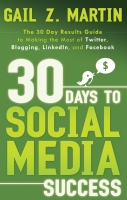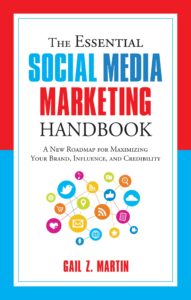 by Gail Z. Martin excerpted from 30 Days to Social Media Success
by Gail Z. Martin excerpted from 30 Days to Social Media Success
Social media has blurred the lines between public relations (PR) and online marketing. It also created a powerful tool for business owners, professionals and authors to reach global audiences and create “viral” buzz in ways that could only be dreamed about by the large advertising agencies of past decades.
While there are some ways in which PR and social media can reinforce each other, there are also distinct differences, and a wise self-promoter will respect the distinctions.
A quick PR primer
Public relations is the art of getting free publicity, usually through coverage in traditional media such as newspapers/magazines, TV and radio. With the growth of the Internet, that field of possibilities has expanded to include the online versions of newspapers and magazines, video sites like YouTube, and both podcasts and online radio shows like those offered by Blog Talk Radio.
The workhorse of traditional PR is the press release, which even in the Internet age remains much the same. The standard format looks like this:
FOR IMMEDIATE RELEASE
CONTACT: (Your name and email or phone here)
Catchy Headline With Good Keywords
City, State: Compelling first sentence with top keywords and action verbs and one or two more short sentences that cover who, what, when, where, and why we should care.
Second short paragraph (one to three sentences) that provide background and context.
Third short paragraph (one to three sentences) that includes a one-line recap of your company and what it does and for whom, plus email, web site and phone.
That’s it—nothing mysterious or esoteric about it, but that deceptively little document will showcase your skill in making editors and readers care about what you’re offering.
One of the biggest changes the Internet has made to public relations is the ability for regular folks who aren’t reporters to find their own news online without the media middlemen. Most people today will run a Google search on a topic rather than wait for tomorrow’s newspaper, next month’s magazine or the 6 o’clock evening news. Online news sites operate 24/7, creating an insatiable demand for news that relies on a steady stream of good story leads from publicists and press releases.
On one hand, that means your news has never been needed as much by news sites as it is today. On the other hand, it means there is an incredible amount of clutter your release must rise above in order to be noticed.
The many new faces of news
Pre-Internet, it was easy to find reporters because they worked for newspapers, magazines, TV or radio. Today, blogs and social media sites have created the rise of the citizen journalist, people who report or comment on topics without formal training or a job with a media outlet. Some sites are private rants, while others show good reportorial skill and a true newshound’s nose for a story. In recent years, bloggers have broken major stories ahead of big newspapers.
News reporting has begun to embrace and cultivate the citizen journalist by providing ways for people to upload their own on-the-scene videos, cell phone photos and reports (for example, CNN). The ability to text, Tweet and photograph via cell phone from a scene with breaking news means that the average person who is in the right place at the right time stands a good chance of being the lead story on the news.
The rise of the citizen journalist coupled with decreasing ad revenue and declining subscriptions has led to the surviving newspapers and magazines cutting back on some sections of coverage. Book reviews are a good example of this trend, and a place where social media sites have more than filled the gap, providing more outlets for coverage than ever before.






